A Convergent Approach to Investigate the Environmental Behavior and Importance of a Man-Made Saltwater Wetland
Abstract
1. Introduction
2. Study Area
3. Materials and Methods
3.1. Water Sample Collection and Analysis
3.2. Sentinel-2 and Meteorological Data Collection
3.3. Hydrological and Hydrochemical Data Elaboration
3.4. Wader Bird Catching and Ringing
3.5. Wader Birds’ Data Elaboration
4. Results
4.1. Temporal Patterns of Drought and Water Availability
4.2. Wetland Main Processes Based on PCA and ICA
4.3. Sources and Drivers of Salinity Variability
4.4. Initial Stages of Brine Formation
4.5. Salinization Pathways
4.6. Wader Bird Monitoring
5. Discussion
6. Conclusions
Supplementary Materials
Author Contributions
Funding
Data Availability Statement
Acknowledgments
Conflicts of Interest
Abbreviations
| GDE | Groundwater dependent ecosystem |
| NDWI | Normalized Difference Water Index |
| PCA | Principal Component Analysis |
| ICA | Independent Component Analysis |
| IC | Independent Component |
| RS | Remote Sensing |
| CP | Campania Plain |
| EC | Electrical Conductivity |
| ORP | Oxidation Reduction Potential |
| DO | Dissolved Oxygen |
| QC | Quality Control |
| DIC | Dissolved Inorganic Carbon |
| TA | Total Alkalinity |
| SI | Saturation Index |
| ESA | European Space Agency |
| PET | Potential Evapotranspiration |
| MODIS | Moderate Resolution Imaging Spectroradiometer |
| NASA | National Aeronautics and Space Administration |
| SPEI | Standardized Precipitation Evapotranspiration Index |
| BEX | Base Exchange |
| KMO | Kaiser–Meyer–Olkin |
| NRSPEC | Number of Birds Species |
| BSD | Bird Species Diversity |
| TDSs | Total Dissolved Solids |
| IUCN | International Union of Conservation of Nature |
References
- Paul, V.G.; Mormile, M.R. A case for the protection of saline and hypersaline environments: A microbiological perspective. Microb. Ecol. 2017, 93, 8. [Google Scholar] [CrossRef] [PubMed]
- Guo, M.; Li, J.; Sheng, C.; Xu, J.; Wu, L. A review of wetland remote sensing. Sensors 2017, 17, 777. [Google Scholar] [CrossRef] [PubMed]
- Liu, J.; Guo, Y.; Han, J.; Yang, F.; Shen, N.; Sun, F.; Wei, Y.; Yuan, P.; Wang, J. Nature-based solutions for landscape performance evaluation-Handan Garden Expo Park’s “Clear as a Drain” artificial wetland as an example. Land 2024, 13, 973. [Google Scholar] [CrossRef]
- Hambäck, P.A.; Dawson, L.; Geranmayeh, P.; Jarsjö, J.; Kačergytė, I.; Peacock, M.; Collentine, D.; Destouni, G.; Futter, M.; Hugelius, G.; et al. Trade-offs and synergies in wetland multifunctionality: A scaling issue. Sci. Total Environ. 2023, 862, 160746. [Google Scholar] [CrossRef]
- Hassan, I.; Chowdhury, S.R.; Prihartato, P.K.; Razzak, S.A. Wastewater treatment using constructed wetlands: Current trends and future potential. Processes 2021, 11, 1917. [Google Scholar] [CrossRef]
- Xu, X.; Chen, M.; Yang, G.; Jiang, B.; Zhang, J. Wetland ecosystem services research: A critical review. Glob. Ecol. Conserv. 2020, 22, e01027. [Google Scholar] [CrossRef]
- Pérez-Ruzafa, A.; Marcos, C.; Pérez-Ruzafa, I.M. Mediterranean coastal lagoons in an ecosystem and aquatic resources management context. Phys. Chem. Earth A/B/C 2011, 36, 160–166. [Google Scholar] [CrossRef]
- Perennou, C.; Gaget, E.; Galewski, T.; Geijzendorffer, I.; Guelmami, A. Evolution of wetlands in the Mediterranean region. In Water Resources in the Mediterranean Region; Elsevier: Amsterdam, The Netherlands, 2020; pp. 297–320. [Google Scholar]
- Sharma, L.K.; Naik, R. Wetland ecosystems. In Conservation of Saline Wetland Ecosystems; Springer Nature: Singapore, 2024; pp. 3–32. [Google Scholar]
- Kudray, G.M.; Gale, M.R. Evaluation of National Wetland Inventory Maps in a Heavily Forested Region in the Upper Great Lakes. Wetlands 2000, 20, 581–587. [Google Scholar] [CrossRef]
- Carol, E.; del Pilar Alvarez, M.; Arcia, M.; Candanedo, I. Surface and groundwater flow exchanges and lateral hydrological connectivity in environments of the Matusagaratí Wetland, Panama. Sci. Total Environ. 2024, 927, 172293. [Google Scholar] [CrossRef]
- Gardner, R.C.; Davidson, N.C. The Ramsar Convention. In Wetlands; Springer: Berlin/Heidelberg, Germany, 2011; pp. 189–203. [Google Scholar]
- Mohanty, S.; Pandey, P.C.; Pandey, M.; Srivastava, P.K.; Dwivedi, C.S. Wetlands contribution and linkage to support SDGs, its indicators and targets-A critical review. Sustain. Develop. 2024, 32, 5348–5392. [Google Scholar] [CrossRef]
- Jie, W.; Xiao, C.; Zhang, C.; Zhang, E.; Li, J.; Wang, B.; Niu, H.; Dong, S. Remote sensing-based dynamic monitoring and environmental change of wetlands in the southern Mongolian Plateau from 2010 to 2018. China Geol. 2021, 4, 1–13. [Google Scholar] [CrossRef]
- Talukdar, S.; Pal, S. Effects of damming on the hydrological regime of Punarbhaba River basin wetlands. Ecol. Eng. 2019, 135, 61–74. [Google Scholar] [CrossRef]
- Levy, Z.F.; Mills, C.T.; Lu, Z.; Goldhaber, M.B.; Rosenberry, D.O.; Mushet, D.M.; Lautz, L.K.; Zhou, X.; Siegel, D.I. Using halogens (Cl, Br, I) to understand the hydrogeochemical evolution of drought-derived saline porewater beneath a prairie wetland. Chem. Geol. 2018, 476, 191–207. [Google Scholar] [CrossRef]
- Scholz, M. Impact of climate change on wetland ecosystems. In Wetlands for Water Pollution Control; Elsevier: Amsterdam, The Netherlands, 2024; pp. 403–430. [Google Scholar]
- Alcalá, F.J.; Custodio, E. Using the Cl/Br ratio as a tracer to identify the origin of salinity in aquifers in Spain and Portugal. J. Hydrol. 2008, 359, 189–207. [Google Scholar] [CrossRef]
- Rao, U.; Hollocher, K.; Sherman, J.; Eisele, I.; Frunzi, M.N.; Swatkoski, S.J.; Hammons, A.L. The use of 36Cl and chloride/bromide ratios in discerning salinity sources and fluid mixing patterns: A case study at Saratoga Springs. Chem. Geol. 2005, 222, 94–111. [Google Scholar] [CrossRef]
- Bodin, H.; Mietto, A.; Ehde, P.M.; Persson, J.; Weisner, S.E.B. Tracer behaviour and analysis of hydraulics in experimental free water surface wetlands. Ecol. Eng. 2012, 49, 201–211. [Google Scholar] [CrossRef]
- Colombani, N.; Alessandrino, L.; Gaiolini, M.; Gervasio, M.P.; Ruberti, D.; Mastrocicco, M. Unravelling the salinity origins in the coastal aquifer/aquitard system of the Volturno River (Italy). Water Res. 2024, 263, 122145. [Google Scholar] [CrossRef]
- Alessandrino, L.; Gaiolini, M.; Cellone, F.A.; Colombani, N.; Mastrocicco, M.; Cosma, M.; Da Lio, C.; Donnici, S.; Tosi, L. Salinity origin in the coastal aquifer of the Southern Venice lowland. Sci. Total Environ. 2023, 905, 167058. [Google Scholar] [CrossRef]
- Mastrocicco, M.; Gervasio, M.P.; Busico, G.; Colombani, N. Natural and anthropogenic factors driving groundwater resources salinization for agricultural use in the Campania plains (Southern Italy). Sci. Total Environ. 2021, 758, 144033. [Google Scholar] [CrossRef]
- Habakaramo Macumu, P.; Gaiolini, M.; Ofori, A.; Mastrocicco, M.; Colombani, N. Additional sources of salinity and heavy metals from plant residues of peaty horizons in the Po River lowland (Italy). Sci. Total Environ. 2024, 957, 177671. [Google Scholar] [CrossRef]
- Xue, J.; Lee, C.; Wakeham, S.G.; Armstrong, R.A. Using principal components analysis (PCA) with cluster analysis to study the organic geochemistry of sinking particles in the ocean. Org. Geochem. 2011, 42, 356–367. [Google Scholar] [CrossRef]
- Bhaduri, D.; Sihi, D.; Bhowmik, A.; Verma, B.C.; Munda, S.; Dari, B. A review on effective soil health bio-indicators for ecosystem restoration and sustainability. Front. Microbiol. 2022, 13, 938481. [Google Scholar] [CrossRef] [PubMed]
- Mott, R.; Prowse, T.A.A.; Jackson, M.V.; Rogers, D.J.; O’Connor, J.A.; Brookes, J.D.; Cassey, P. Measuring habitat quality for waterbirds: A review. Ecol. Evol. 2023, 13, 4. [Google Scholar] [CrossRef] [PubMed]
- Aslan, H.; Elipek, B.; Gönülal, O.; Baytut, Ö.; Kurt, Y.; İnanmaz, Ö.E. Gökçeada Salt Lake: A Case Study of Seasonal Dynamics of Wetland Ecological Communities in the Context of Anthropogenic Pressure and Nature Conservation. Wetlands 2021, 41, 2. [Google Scholar] [CrossRef]
- Prateek, A.M.; Mishra, H.; Kumar, V.; Kumar, A. Temporal pattern in foraging behaviour of Vanellus malabaricus in relation to different seasons and habitats. Avian Biol. Res. 2024, 17, 22–30. [Google Scholar] [CrossRef]
- Qiu, J.; Zhang, Y.; Ma, J. Wetland habitats supporting waterbird diversity: Conservation perspective on biodiversity-ecosystem functioning relationship. J. Environ. Manag. 2024, 357, 120663. [Google Scholar] [CrossRef]
- Milia, A.; Torrente, M.M. Late-Quaternary volcanism and transtensional tectonics in the Bay of Naples, Campanian continental margin, Italy. Mineral. Petrol. 2003, 79, 49–65. [Google Scholar] [CrossRef]
- Sacchi, M.; Molisso, F.; Pacifico, A.; Vigliotti, M.; Sabbarese, C.; Ruberti, D. Late-Holocene to recent evolution of Lake Patria, South Italy: An example of a coastal lagoon within a Mediterranean delta system. Glob. Planet. Change 2014, 117, 9–27. [Google Scholar] [CrossRef]
- Amorosi, A.; Pacifico, A.; Rossi, V.; Ruberti, D. Late Quaternary incision and deposition in an active volcanic setting: The Volturno valley fill, southern Italy. Sediment. Geol. 2012, 282, 307–320. [Google Scholar] [CrossRef]
- Usai, A. L’Inanellamento Nella Zona Umida “Le Soglitelle” Report Anno 2020-“Le Soglitelle” Bird Ringing Report 2020; Technical Report; Istituto di Gestione della Fauna: Naples, Italy, 2021. [Google Scholar]
- Kløve, B.; Ala-aho, P.; Bertrand, G.; Boukalova, Z.; Ertürk, A.; Goldscheider, N.; Ilmonen, J.; Karakaya, N.; Kupfersberger, H.; Kvœrner, J.; et al. Groundwater dependent ecosystems. Part I: Hydroecological status and trends. Environ. Sci. Policy 2011, 14, 770–781. [Google Scholar] [CrossRef]
- Copernicus Browser. Available online: https://browser.dataspace.copernicus.eu/ (accessed on 1 April 2025).
- Mastronardi, D.; Esse, E.; Balestrieri, R.; De Rosa, D.; Giannotti, M.; Piciocchi, S. The bird communities of four wetlands on the Tyrrhenian coast NW of Naples in relation to human disturbance. Riv. Ital. Ornitol. 2012, 82, 1–2. [Google Scholar] [CrossRef][Green Version]
- Cook, S.; Peacock, M.; Evans, C.D.; Page, S.E.; Whelan, M.J.; Gauci, V.; Kho, L.K. Quantifying tropical peatland dissolved organic carbon (DOC) using UV-visible spectroscopy. Water Res. 2017, 115, 229–235. [Google Scholar] [CrossRef] [PubMed]
- Parkhurst, D.L.; Appelo, C.A.J. Description of Input and Examples for PHREEQC Version 3: A Computer Program for Speciation, Batch-reaction, One-dimensional Transport, and Inverse Geochemical Calculations (No. 6-A43). USGS 2013. US Geol. Surv. Tech. Methods 2013, 6, 487. [Google Scholar]
- European Space Agency (ESA). Sentinel-2: ESA’s Optical High-Resolution Mission for GMES Operational Services. ESA SP-1322/2. March 2012. Available online: https://www.esa.int/About_Us/ESA_Publications/ESA_SP-1322_2_Sentinel_2 (accessed on 1 April 2025).
- McFeeters, S.K. The use of the Normalized Difference Water Index (NDWI) in the delineation of open water features. Int. J. Remote Sens. 1996, 17, 1425–1432. [Google Scholar] [CrossRef]
- Centro Funzionale Multirischi Della Protezione Civile Regione Campania. Available online: https://centrofunzionale.regione.campania.it/ (accessed on 1 April 2025).
- Moderate Resolution Imaging Spectroradiometer (MODIS). Available online: https://www.spiedigitallibrary.org/conference-proceedings-of-spie/1939/0000/Moderate-Resolution-Imaging-Spectroradiomete-MODIS/10.1117/12.152835.short#_=_ (accessed on 1 April 2025).
- Beguería, S.; Vicente-Serrano, S.M.; Reig, F.; Latorre, B. Standardized precipitation evapotranspiration index (SPEI) revisited: Parameter fitting, evapotranspiration models, tools, datasets and drought monitoring. Int. J. Climatol. 2013, 34, 3001–3023. [Google Scholar] [CrossRef]
- Jin, X.; Qiang, H.; Zhao, L.; Jiang, S.; Cui, N.; Cao, Y.; Feng, Y. SPEI-based analysis of spatio-temporal variation characteristics for annual and seasonal drought in the Zoige Wetland, Southwest China from 1961 to 2016. Theor. Appl. Climatol. 2019, 139, 711–725. [Google Scholar] [CrossRef]
- Stuyfzand, P.J. Base exchange indices as indicators of salinization or freshening of (coastal) aquifers. In Proceedings of the 18th Salt Water Intrusion Meeting (SWIM), Cartagena, Spain, 31 May–3 June 2004. [Google Scholar]
- Iwamori, H.; Yoshida, K.; Nakamura, H.; Kuwatani, T.; Hamada, M.; Haraguchi, S.; Ueki, K. Classification of geochemical data based on multivariate statistical analyses: Complementary roles of cluster, principal component, and independent component analyses. Geochem. Geophys. 2017, 18, 994–1012. [Google Scholar] [CrossRef]
- Shahrestani, S.; Cohen, D.R.; Mokhtari, A.R. A comparison of PCA and ICA in geochemical pattern recognition of soil data: The case of Cyprus. J. Geochem. Explor. 2024, 264, 107539. [Google Scholar] [CrossRef]
- Perez, M.; Lombardi, D.; Bardino, G.; Vitale, M. Drought assessment through actual evapotranspiration in Mediterranean vegetation dynamics. Ecol Indic. 2024, 166, 112359. [Google Scholar] [CrossRef]
- Li, B.; Zhou, W.; Zhao, Y.; Ju, Q.; Yu, Z.; Liang, Z.; Acharya, K. Using the SPEI to assess recent climate change in the Yarlung Zangbo River Basin, South Tibet. Water 2015, 7, 5474–5486. [Google Scholar] [CrossRef]
- Junk, W.J. World wetlands classification: A new hierarchic hydro-ecological approach. Wetl. Ecol. Manag. 2024, 32, 975–1001. [Google Scholar] [CrossRef]
- Zhao, K.; Bao, K.; Yan, Y.; Neupane, B.; Gao, C. Spatial distribution of potentially harmful trace elements and ecological risk assessment in Zhanjiang mangrove wetland, South China. Mar. Pollut. Bull. 2022, 182, 114033. [Google Scholar] [CrossRef] [PubMed]
- Colombani, N.; Cuoco, E.; Mastrocicco, M. Origin and pattern of salinization in the Holocene aquifer of the southern Po Delta (NE Italy). J. Geochem. Explor. 2017, 175, 130–137. [Google Scholar] [CrossRef]
- Parker, S.R.; Darvis, M.N.; Poulson, S.R.; Gammons, C.H.; Stanford, J.A. Dissolved oxygen and dissolved inorganic carbon stable isotope composition and concentration fluxes across several shallow floodplain aquifers and in a diffusion experiment. Biogeochemistry 2013, 117, 539–552. [Google Scholar] [CrossRef]
- Gammons, C.H.; Babcock, J.N.; Parker, S.R.; Poulson, S.R. Diel cycling and stable isotopes of dissolved oxygen, dissolved inorganic carbon, and nitrogenous species in a stream receiving treated municipal sewage. Chem. Geol. 2010, 238, 44–55. [Google Scholar] [CrossRef]
- Cai, W.J.; Dai, M.; Wang, Y.; Zhai, W.; Huang, T.; Chen, S.; Zhang, F.; Chen, Z.; Wang, Z. The biogeochemistry of inorganic carbon and nutrients in the Pearl River estuary and the adjacent Northern South China Sea. Cont. Shelf Res. 2004, 24, 1301–1319. [Google Scholar] [CrossRef]
- Hyvärinen, A. Independent component analysis: Recent advances. Philos. Trans. R. Soc. 2013, 371, 20110534. [Google Scholar] [CrossRef]
- Schiavo, M.; Colombani, N.; Mastrocicco, M. Modeling stochastic saline groundwater occurrence in coastal aquifers. Water Res. 2023, 235, 119885. [Google Scholar] [CrossRef]
- Vahidipour, M.; Raeisi, E.; van der Zee, S.E.A.T.M. Temporal dynamics of inundation area, hydrochemistry and brine in Bakhtegan Lake, South-Central Iran. J. Hydrol. Reg. 2024, 52, 101714. [Google Scholar] [CrossRef]
- Fontes, J.C.; Matray, J.M. Geochemistry and origin of formation brines from the Paris Basin, France. Chem. Geol. 1993, 109, 149–175. [Google Scholar] [CrossRef]
- Corniello, A.; Ducci, D.; Stellato, L.; Stevenazzi, S.; Massaro, L.; Del Gaudio, E. Combining groundwater budget, hydrochemistry and environmental isotopes to identify the groundwater flow in carbonate aquifers located in Campania Region (Southern Italy). J. Hydrol. Reg. Stud. 2024, 53, 101790. [Google Scholar] [CrossRef]
- Bordbar, M.; Busico, G.; Sirna, M.; Tedesco, D.; Mastrocicco, M. A multi-step approach to evaluate the sustainable use of groundwater resources for human consumption and agriculture. J. Environ. Manag. 2023, 347, 119041. [Google Scholar] [CrossRef] [PubMed]
- Corniello, A.; Ducci, D. Hydrogeochemical characterization of the main aquifer of the “Litorale Domizio-Agro Aversano NIPS” (Campania—Southern Italy). J. Geochem. Explor. 2014, 137, 1–10. [Google Scholar] [CrossRef]
- Meyer, R.; Engesgaard, P.; Sonnenborg, T.O. Origin and dynamics of saltwater intrusion in a regional aquifer: Combining 3-D saltwater modeling with geophysical and geochemical data. Water Resour. Res. 2023, 55, 1792–1813. [Google Scholar] [CrossRef]
- Gattacceca, J.C.; Vallet-Coulomb, C.; Mayer, A.; Claude, C.; Radakovitch, O.; Conchetto, E.; Hamelin, B. Isotopic and geochemical characterization of salinization in the shallow aquifers of a reclaimed subsiding zone: The southern Venice Lagoon coastland. J. Hydrol. 2009, 378, 46–61. [Google Scholar] [CrossRef]
- Castrillon-Munoz, F.J.; Gibson, J.J.; Birks, S.J. Carbon dissolution effects on pH changes of RAMP lakes in northeastern Alberta, Canada. J. Hydrol. Reg. Stud. 2022, 40, 101045. [Google Scholar] [CrossRef]
- Ruberti, D.; Buffardi, C.; Sacchi, M.; Vigliotti, M. The late Pleistocene-Holocene changing morphology of the Volturno delta and coast (northern Campania, Italy): Geological architecture and human influence. Quat. Int. 2022, 625, 14–28. [Google Scholar] [CrossRef]
- Guglielmi, M.; De Filippo, G.; Elicio, F.; Usai, A. A review of knowledge on dragonflies and damselflies in the Regional Nature Reserve “Foce Volturno – Costa di Licola”. BORNH Bull. Reg. Nat. Hist. 2024, 4, 32–43. [Google Scholar]
- De Knijf, G.; Billqvist, M.; van Grunsven, R.; Allen, D.; Assandri, G.; Bellotto, V.; Bruslund, S.; Bedjanič, M.; Conze, K.J.; Díaz Martínez, C.; et al. European Dragonflies: Moving from Assessment to Conservation Planning. A Report to the European Commission by the IUCN SSC Dragonfly Specialist Group and the IUCN SSC Conservation Planning Specialist Group; Conservation Planning Specialist Group: Apple Valley, MN, USA, 2024. [Google Scholar]
- Oertli, B. The use of dragonflies in the assessment and monitoring of aquatic habitats. In Dragonflies and Damselflies: Model Organisms for Ecological and Evolutionary; Oxford University Press: Oxford, UK, 2008; pp. 79–96. [Google Scholar]
- Schagerl, M. Soda Lakes of East Africa; Springer International Publishing: Cham, Switzerland, 2016. [Google Scholar]
- Finlayson, C.M.; Milton, G.R.; Prentice, R.C.; Davidson, N.C. The Wetland Book; Springer: Dordrecht, The Netherlands, 2018. [Google Scholar]
- Gutiérrez, J.S. Living in Environments with Contrasting Salinities: A Review of Physiological and Behavioural Responses in Waterbirds. Ardeola 2014, 61, 233–256. [Google Scholar] [CrossRef]
- Seker, M.; Gumus, V. Projection of temperature and precipitation in the Mediterranean region through multi-model ensemble from CMIP6. Atmos. Res. 2022, 280, 106440. [Google Scholar] [CrossRef]
- Kirby, J.S.; Stattersfield, A.J.; Butchart, S.H.M.; Evans, M.I.; Grimmett, R.F.A.; Jones, V.R.; O’Sullivan, J.; Tucker, G.M.; Newton, I. Key conservation issues for migratory land- and waterbird species on the world’s major flyways. Bird Conserv. Int. 2008, 18, 49–73. [Google Scholar] [CrossRef]
- Saccò, M.; White, N.E.; Harrod, C.; Salazar, G.; Aguilar, P.; Cubillos, C.F.; Meredith, K.; Baxter, B.K.; Oren, A.; Anufriieva, E.; et al. Salt to conserve: A review on the ecology and preservation of hypersaline ecosystems. Biol. Rev. 2021, 96, 2828–2850. [Google Scholar] [CrossRef] [PubMed]
- Lefebvre, G.; Redmond, L.; Germain, C.; Palazzi, E.; Terzago, S.; Willm, L.; Poulin, B. Predicting the vulnerability of seasonally-flooded wetlands to climate change across the Mediterranean Basin. Sci. Total Environ. 2019, 692, 546–555. [Google Scholar] [CrossRef] [PubMed]
- Middleton, B.A.; Boudell, J. Salinification of Coastal Wetlands and Freshwater Management to Support Resilience. Ecosyst. Health Sustain. 2023, 9, 83. [Google Scholar] [CrossRef]
- Huang, L.; Zhang, G.; Bai, J.; Xia, Z.; Wang, W.; Jia, J.; Wang, X.; Liu, X.; Cui, B. Desalinization via freshwater restoration highly improved microbial diversity, co-occurrence patterns and functions in coastal wetland soils. Sci. Total Environ. 2021, 765, 142769. [Google Scholar] [CrossRef]
- Alessandrino, L.; Giuditta, E.; Faugno, S.; Colombani, N.; Mastrocicco, M. Direct and Remote Sensing Monitoring of Plant Salinity Stress in a Coastal Back-Barrier Environment: Mediterranean Pine Forest Stress and Mortality as a Case Study. Remote Sens. 2024, 16, 3150. [Google Scholar] [CrossRef]
- Albertini, C.; Gioia, A.; Iacobellis, V.; Manfreda, S. Detection of Surface Water and Floods with Multispectral Satellites. Remote Sens. 2022, 14, 6005. [Google Scholar] [CrossRef]
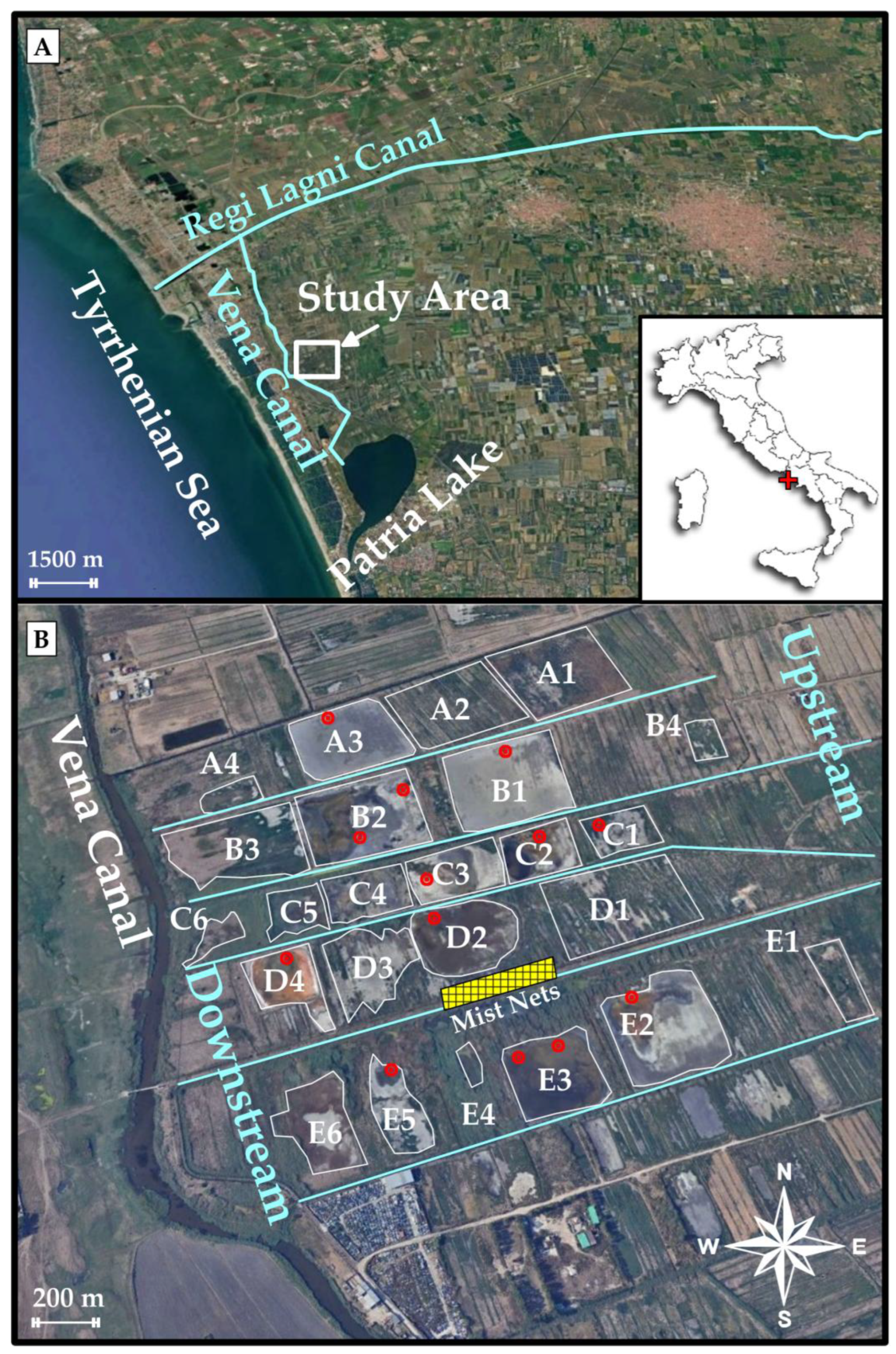

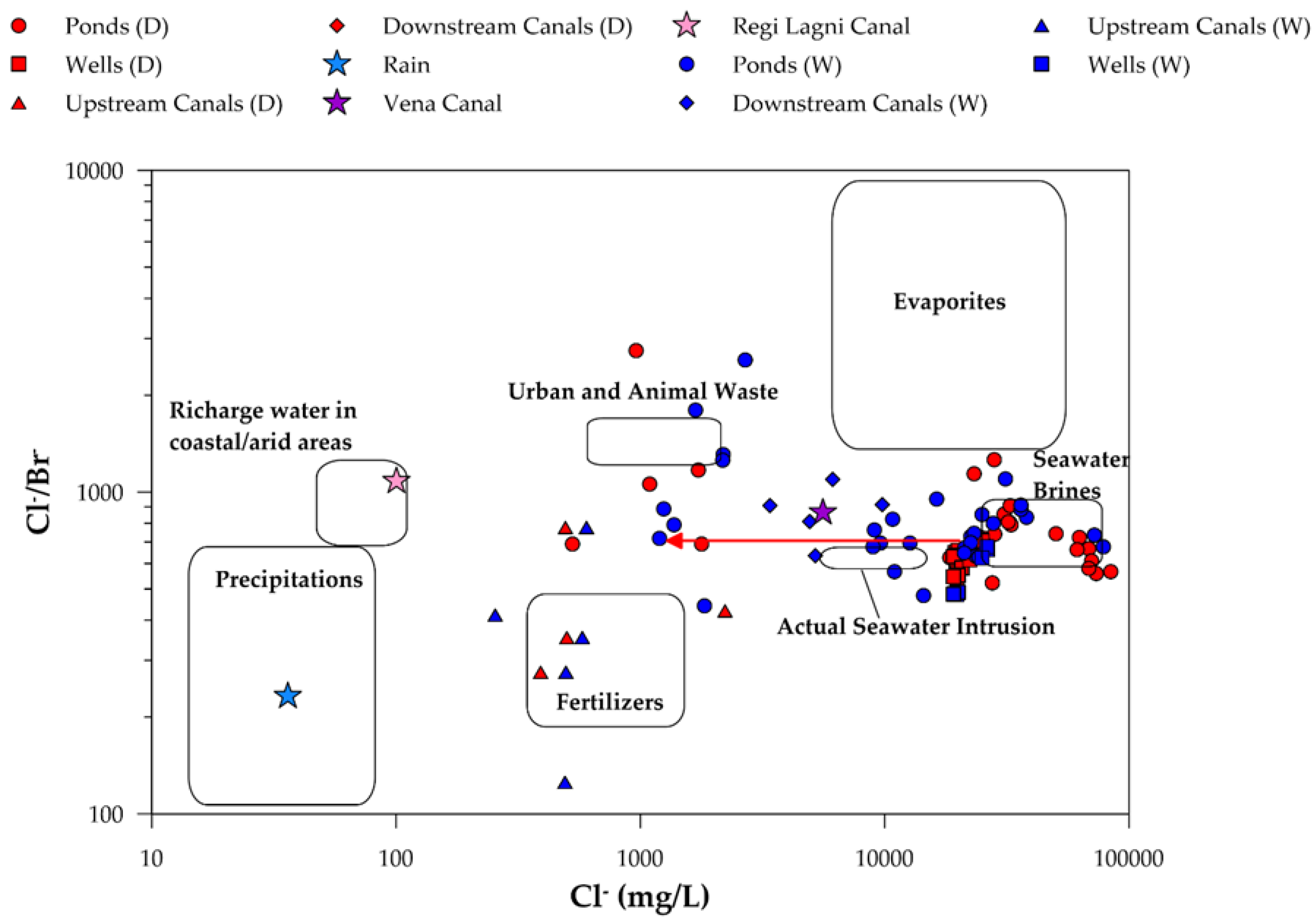

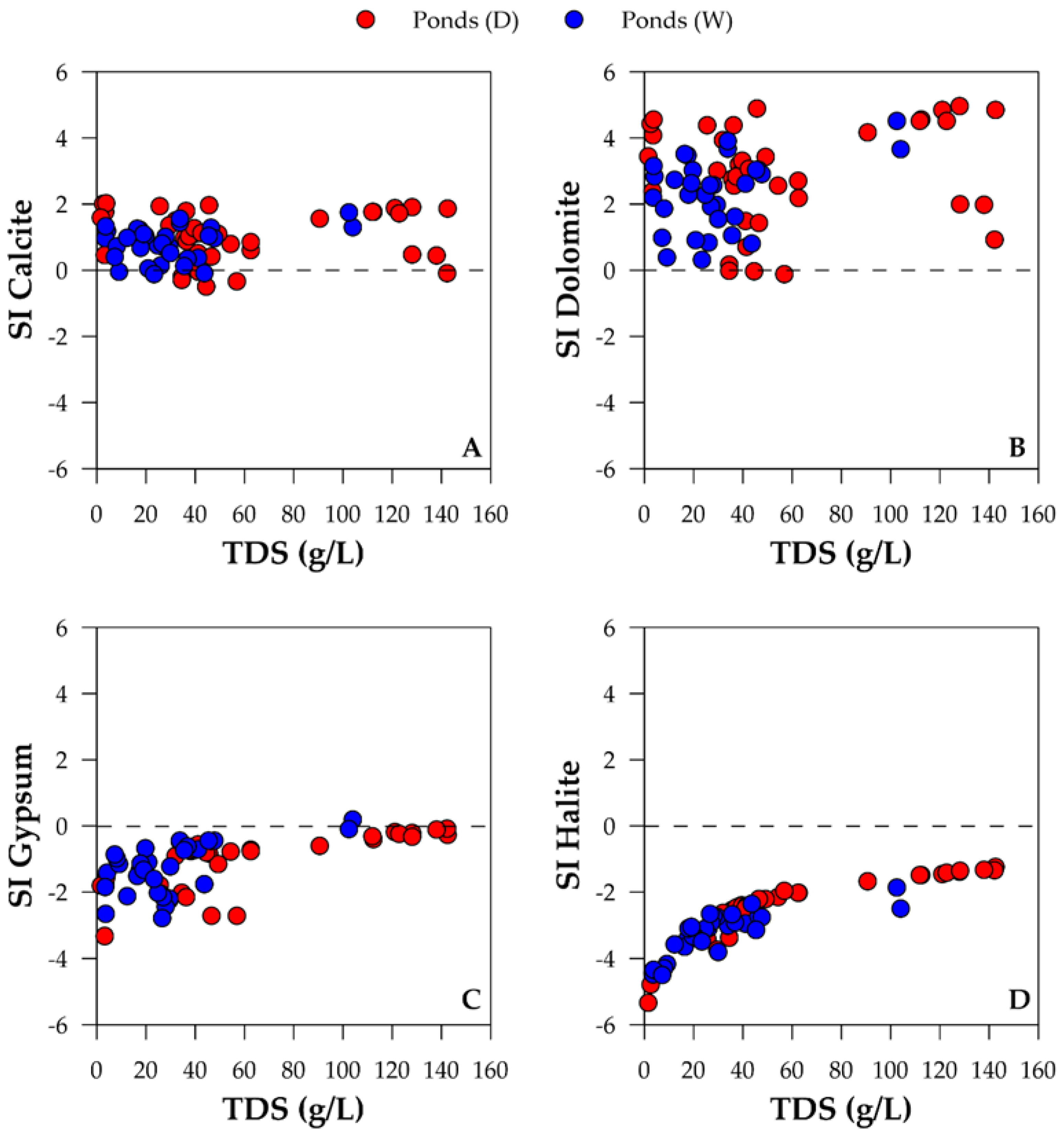
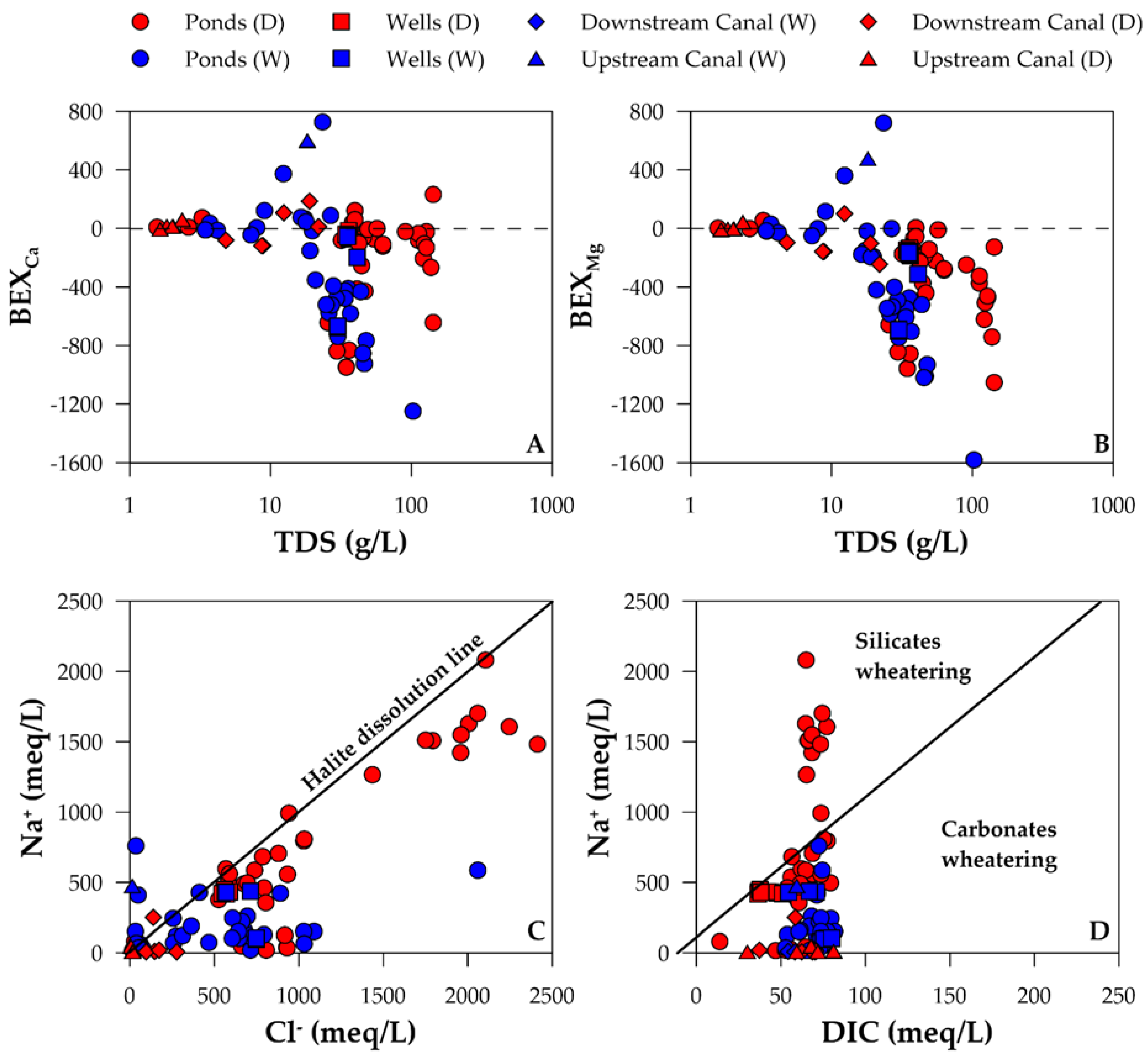
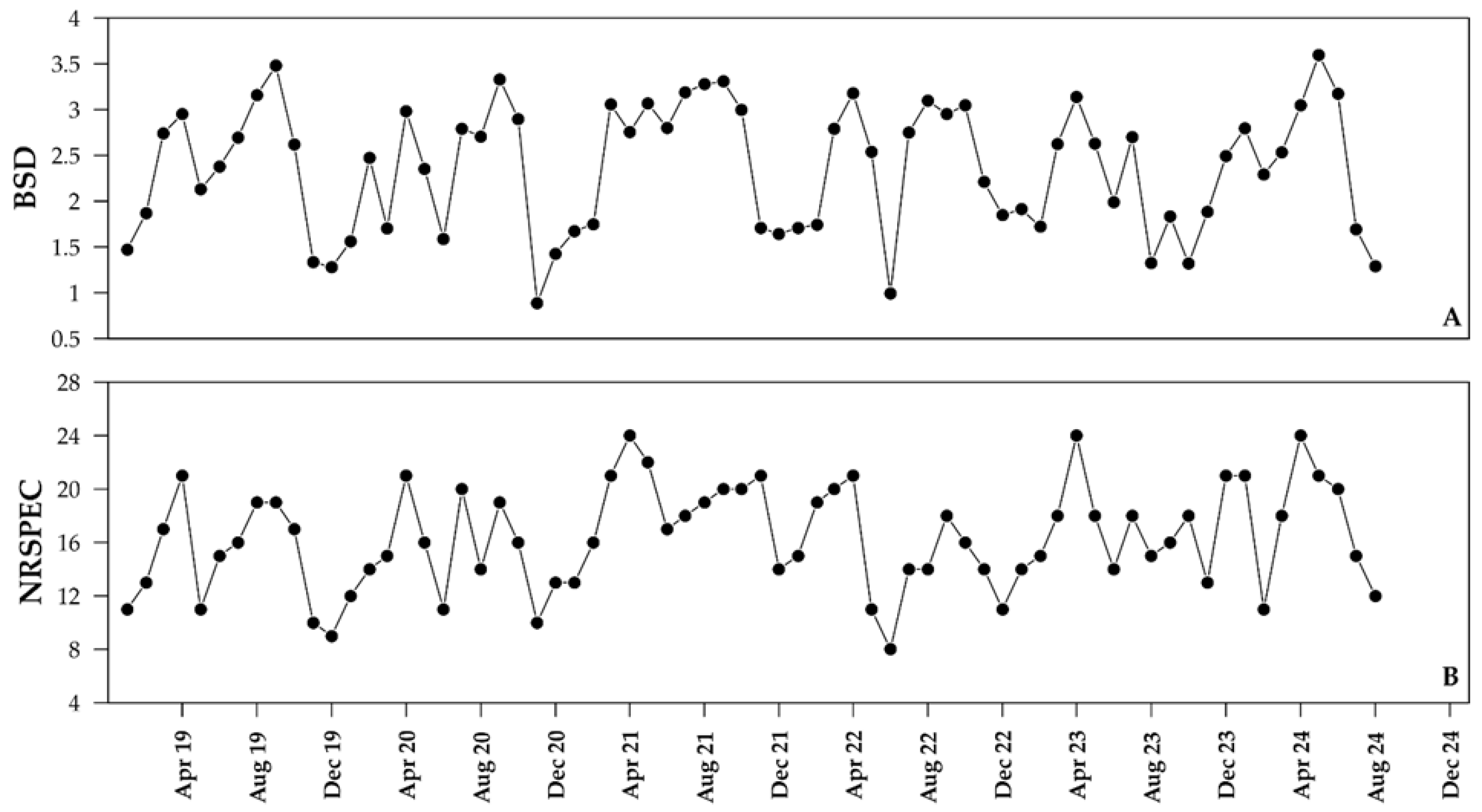
| Moisture Category | SPEI |
|---|---|
| Extremely wet | >2.00 |
| Very wet | 1.50 to 1.99 |
| Moderately wet | 1.00 to 1.49 |
| Near normal | −0.99 to 0.99 |
| Moderately dry | −1.00 to −1.49 |
| Severely dry | −1.50 to −1.99 |
| Extremely dry | <−2.00 |
| Dry Period | Wet Period | ||||||||
|---|---|---|---|---|---|---|---|---|---|
| Component | |||||||||
| ID | 1 | 2 | 3 | 4 | 1 | 2 | 3 | 4 | 5 |
| Explained Variance (%) | 45.68 | 13.17 | 11.67 | 11.27 | 23.72 | 21.47 | 12.86 | 12.1 | 8.37 |
| NO3 | −0.26 | 0.89 | −0.02 | 0.08 | −0.09 | −0.12 | 0.90 | 0.00 | 0.08 |
| PO4 | −0.23 | 0.90 | −0.02 | −0.10 | −0.22 | −0.04 | 0.88 | −0.09 | −0.04 |
| SO4 | 0.96 | −0.14 | 0.06 | −0.06 | 0.24 | 0.81 | −0.13 | −0.04 | 0.38 |
| DIC | 0.18 | 0.04 | 0.82 | −0.19 | 0.26 | −0.14 | 0.11 | 0.63 | −0.03 |
| TDS | 0.93 | −0.21 | 0.23 | 0.04 | 0.86 | 0.40 | −0.20 | 0.03 | 0.12 |
| pH | −0.14 | −0.06 | 0.19 | 0.73 | −0.34 | 0.31 | −0.15 | 0.01 | −0.30 |
| ORP | 0.10 | 0.03 | −0.23 | 0.89 | −0.08 | −0.08 | 0.01 | 0.78 | 0.06 |
| DO | 0.26 | −0.16 | 0.71 | 0.35 | −0.14 | 0.14 | −0.23 | 0.83 | −0.06 |
| DOC | 0.57 | 0.32 | 0.39 | −0.11 | 0.19 | 0.61 | 0.35 | 0.26 | −0.31 |
| K | 0.89 | −0.21 | 0.02 | −0.13 | 0.33 | 0.86 | −0.14 | −0.17 | 0.05 |
| Mg | 0.95 | −0.17 | 0.05 | −0.05 | 0.38 | 0.87 | −0.13 | −0.08 | 0.01 |
| Ca | 0.94 | −0.06 | 0.07 | −0.01 | 0.70 | 0.51 | 0.02 | −0.04 | −0.19 |
| F | 0.53 | −0.13 | −0.38 | −0.37 | −0.01 | 0.13 | 0.02 | 0.00 | 0.93 |
| Cl | 0.89 | −0.24 | 0.27 | 0.04 | 0.92 | 0.24 | −0.16 | 0.03 | 0.03 |
| Br | 0.92 | −0.18 | 0.20 | 0.07 | 0.93 | 0.22 | −0.14 | −0.01 | 0.02 |
| Dry Period | Wet Period | ||||||||
|---|---|---|---|---|---|---|---|---|---|
| Independent Component | |||||||||
| ID | 1 | 2 | 3 | 4 | 1 | 2 | 3 | 4 | 5 |
| pH | 0.08 | 0.21 | 0.16 | 0.71 | 0.06 | 0.11 | 0.46 | 0.25 | 0.09 |
| ORP | 0.08 | 0.19 | 0.44 | 0.79 | 0.41 | 0.08 | 0.36 | 0.61 | 0.03 |
| DO | 0.34 | 0.64 | 0.40 | 0.18 | 0.27 | 0.27 | 0.06 | 0.79 | 0.08 |
| DOC | 0.16 | 0.39 | 0.43 | 0.38 | 0.16 | 0.28 | 0.29 | 0.41 | 0.39 |
| Na | 0.30 | 0.07 | 0.86 | 0.28 | 0.37 | 0.43 | 0.33 | 0.18 | 0.19 |
| K | 0.29 | 0.12 | 0.73 | 0.46 | 0.03 | 0.20 | 0.82 | 0.15 | 0.44 |
| Mg | 0.27 | 0.08 | 0.82 | 0.41 | 0.02 | 0.21 | 0.77 | 0.06 | 0.41 |
| Ca | 0.17 | 0.04 | 0.85 | 0.38 | 0.31 | 0.11 | 0.55 | 0.07 | 0.42 |
| F | 0.09 | 0.47 | 0.29 | 0.41 | 0.75 | 0.05 | 0.03 | 0.36 | 0.16 |
| Cl | 0.38 | 0.12 | 0.82 | 0.31 | 0.25 | 0.30 | 0.29 | 0.18 | 0.80 |
| Br | 0.31 | 0.06 | 0.87 | 0.30 | 0.25 | 0.30 | 0.31 | 0.23 | 0.80 |
| NO3 | 0.90 | 0.21 | 0.12 | 0.12 | 0.09 | 0.89 | 0.17 | 0.00 | 0.01 |
| PO4 | 0.89 | 0.20 | 0.15 | 0.06 | 0.03 | 0.89 | 0.00 | 0.01 | 0.07 |
| SO4 | 0.25 | 0.07 | 0.83 | 0.43 | 0.38 | 0.19 | 0.72 | 0.17 | 0.49 |
| DIC | 0.17 | 0.78 | 0.13 | 0.30 | 0.01 | 0.03 | 0.43 | 0.50 | 0.21 |
| TDS | 0.34 | 0.08 | 0.86 | 0.33 | 0.07 | 0.37 | 0.18 | 0.21 | 0.86 |
Disclaimer/Publisher’s Note: The statements, opinions and data contained in all publications are solely those of the individual author(s) and contributor(s) and not of MDPI and/or the editor(s). MDPI and/or the editor(s) disclaim responsibility for any injury to people or property resulting from any ideas, methods, instructions or products referred to in the content. |
© 2025 by the authors. Licensee MDPI, Basel, Switzerland. This article is an open access article distributed under the terms and conditions of the Creative Commons Attribution (CC BY) license (https://creativecommons.org/licenses/by/4.0/).
Share and Cite
Alessandrino, L.; Colombani, N.; Usai, A.; Mastrocicco, M. A Convergent Approach to Investigate the Environmental Behavior and Importance of a Man-Made Saltwater Wetland. Remote Sens. 2025, 17, 2019. https://doi.org/10.3390/rs17122019
Alessandrino L, Colombani N, Usai A, Mastrocicco M. A Convergent Approach to Investigate the Environmental Behavior and Importance of a Man-Made Saltwater Wetland. Remote Sensing. 2025; 17(12):2019. https://doi.org/10.3390/rs17122019
Chicago/Turabian StyleAlessandrino, Luigi, Nicolò Colombani, Alessio Usai, and Micòl Mastrocicco. 2025. "A Convergent Approach to Investigate the Environmental Behavior and Importance of a Man-Made Saltwater Wetland" Remote Sensing 17, no. 12: 2019. https://doi.org/10.3390/rs17122019
APA StyleAlessandrino, L., Colombani, N., Usai, A., & Mastrocicco, M. (2025). A Convergent Approach to Investigate the Environmental Behavior and Importance of a Man-Made Saltwater Wetland. Remote Sensing, 17(12), 2019. https://doi.org/10.3390/rs17122019










